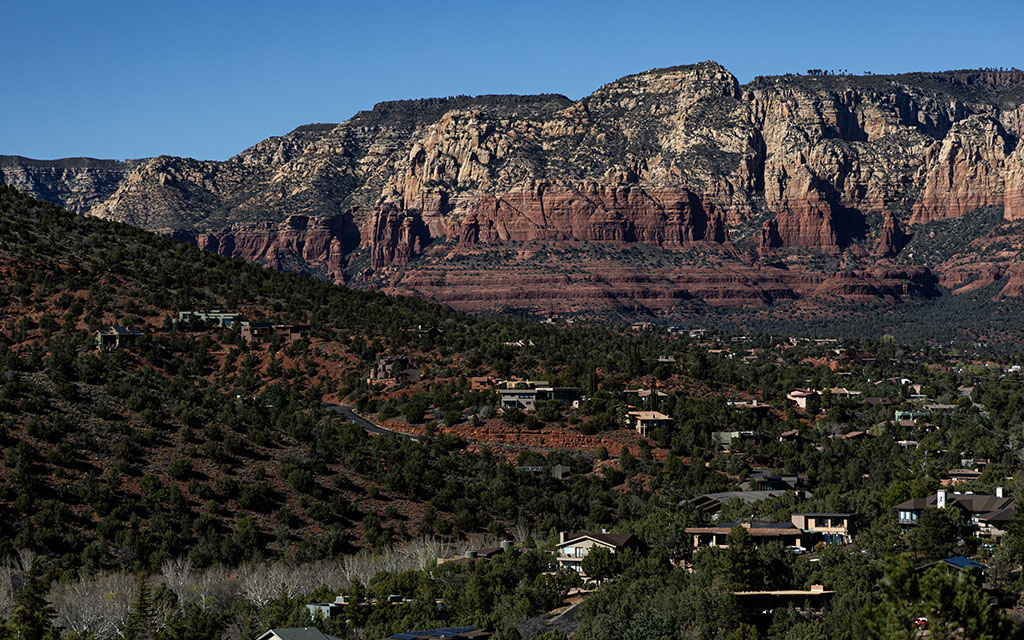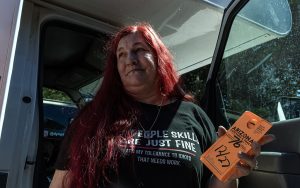
Some opponents of the Safe Place to Park program argue that the Cultural Park and the amphitheater should be revived as a performance venue instead of being used for the program that aims to ease homelessness. Photo taken in Sedona on April 3, 2024. (Photo by Emily Mai/Cronkite News)

Jodi Jackson is a prime candidate for the Safe Place to Park Program. She currently lives out of an RV and works at a laundromat in Sedona. Photo taken in Sedona on April 3, 2024. (Photo by Emily Mai/Cronkite News)

Sedona is a popular tourist destination, and opponents of the Safe Place to Park Program community. Photo taken in Sedona on April 3, 2024. (Photo by Emily Mai/Cronkite News)
SEDONA – Sedona has been looking for solutions to its homelessness problem and city leaders think the Safe Place to Park Program could be a step in the right direction, but residents against the program have stalled the measure by pushing to take the issue to a public vote in November.
The program is meant for people who work in Sedona but can’t find affordable housing there and are living out of their vehicles. The proposed program would provide legal overnight parking, some amenities and help finding housing. To be eligible for the program, participants would have to prove employment in the city and have a registered and insured vehicle.
The Sedona City Council voted 6-1 on March 12 to approve the zoning change that would make the program possible.

Sedona City Councilor Jessica Williamson said the now-stalled Safe Place to Park Program aims to keep this workforce intact until the city can get more housing built. (Photo by Emily Mai/Cronkite News)
City Councilor Jessica Williamson said the program, which is expected to run for up to two years, aims to keep this workforce intact until the city can get more housing built. Williamson also wants the public to know that there will be security and police presence in the area.
The proposed parking lot is in the northwest corner of the 40-acre Cultural Park area, a former performance venue owned by the city. According to Williamson, the lot can’t be seen from city streets and is not currently in use. It will be able to accommodate up to 40 vehicles and would be closed during the day from 8 a.m. to 4 p.m.
Participants in the program would sleep in their respective vehicles, and the city would provide amenities, such as showers, bathrooms and a place for approved participants to cook their meals.
Opponents of the program have expressed concerns that using the lot for the program would bring down the value of the Cultural Park and lead to illegal activity, such as drug use. The Sedona Votes website points out that the program doesn’t solve the problem of homeless workers needing permanent housing. The Save the Cultural Park effort also includes a desire to see the park brought back as an entertainment venue.
Bill Noonan, who spoke at the March council meeting ahead of the zoning vote said he moved to Sedona to get away from another homelessness issue. “If the city does pass this misbegotten zoning ordinance, I’ve already prepared and tomorrow I will file for a ballot referendum so the people of Sedona can correct that mistake.”
Save the Cultural Park Committee announced on its website that it collected enough signatures for a November referendum on the issue, and in an April 23 executive session, the City Council decided to put the program on hold until after the November election.
Williamson said some people are against the program and the participants because they equate homelessness with a stereotype of people who are on the streets due to mental health issues and drug abuse.
“This is a limited program, there are 40 spots, people have to apply and show a lot of identification and evidence that they are working,” Williamson said. “There is going to be on-site management that is experienced with the homeless population. The people that need this program are willing to work, they are just down on their luck.”
Williamson said the people who need the program are “servers at restaurants and are basically your neighbors. If we do not help those people, we would be in a much worse situation.” According to Williamson, the nearest homeless shelter is in Cottonwood, about 20 miles away.
The program aims to help people get back on their feet, but proponents recognize it’s likely a temporary solution.
“If the program is not working or we think it is not working, we can shut it down overnight. We just would not open the doors in the morning,” Williamson said.

Jodi Jackson, who works at a Sedona laundromat and lives out of an RV, poses with a handful of day passes she purchased at Arizona state parks so she could park her RV there overnight. Photo taken in Sedona on April 3, 2024. (Photo by Emily Mai/Cronkite News)
Jodi Jackson is a prime candidate for the Safe Place to Park Program. Jackson was living with a friend until the roof collapsed. She had to move out and currently lives out of an RV. She works at a laundromat in Sedona, where she does laundry for Airbnbs and dropoffs.
“The program would give me a safe place to be at night. Right now I am going between Sedona and Cottonwood to find a place to stay,” Jackson said.
Jackson parks in a shopping center or grocery store parking lot. When she is in those areas at night, she worries about police kicking her out of the lot. Jackson said she can’t afford housing in Sedona with the wage she makes, and she does not want to go live in a shelter because she doesn’t want to take a spot from someone who would need it more than she does.
“This is a temporary fix to a big problem. This is not a long-term fix to this problem,” Jackson said. “This is the first step to fixing it, we’ve got to start somewhere. Why not help those who run your gas stations, the servers at restaurants, people working the laundromats and grocery stores. If no one is here to do these jobs, then who is going to do them?”



